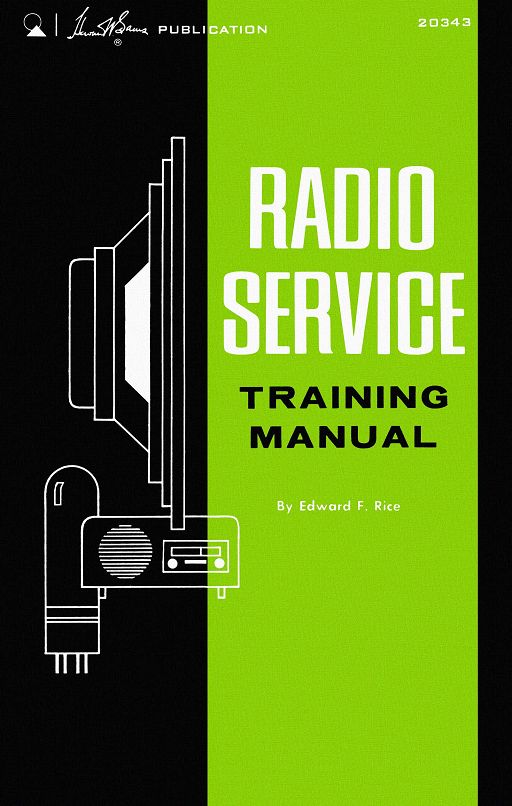Contents
SECTION 1--INTRODUCTION
Organization of This Book - Suggestions for Working on the Chassis
SECTION 2--AM RECEIVERS WITH TUBES
The Power Supply - Dead Receiver - The Audio Stages -The Oscillator and Mixer or Converter - The Intermediate Frequency Amplifier - The Diode Detector Circuit – QUIZ
SECTION 3--No SIGNALS, AUDIO FAILURE - QUIZ - Servicing Chart I
SECTION 4--No SIGNALS, RF OR IF FAILURE - QUIZ - Servicing Chart II
SECTION 5--DISTORTION - Uncontrollable 60-Cycle Hum - Tunable Hum - Squeals and Motorboating - QUIZ - Servicing Chart III
SECTION 6--WEAK, NOISY SIGNALS - QUIZ - Servicing Chart IV
SECTION 7--REPAIRING 3-WAY PORTABLE RECEIVERS - Circuit Analysis of Power Supply - Other Circuit Differences - Troubleshooting Procedures - Dead Receiver with Tubes OK - Frequent Tube Burnout- Distortion and Tunable Hum - QUIZ - Servicing Chart V
SECTION 8--FUNDAMENTALS OF TRANSISTOR RECEIVERS - How Transistors Amplify - Biasing and Stability - Automatic Gain Control of Transistor Stages - Power Supply and Decoupling - Audio Output Stages - The Mixer/Oscillator Stage - QUIZ
SECTION 9--No-SIGNAL SYMPTOM IN TRANSISTOR RECEIVERS - Symptom - No Signals - QUIZ - Servicing Chart VI - Servicing Chart VII - Servicing Chart VIII
SECTION 10--ADDITIONAL SYMPTOMS IN TRANSISTOR RECEIVERS - Distortion - Oscillation or Motorboating - QUIZ- Servicing Chart IX - Servicing Chart X - Servicing Chart XI
SECTION 11--AUTO RADIOS - Vibrator-Type Power Supplies - Automatic-Tuning Signal Seeking Circuits - 12-Volt Hybrid Receivers - Transistor Output Stages - Direct-Coupled Transistor Stages - QUIZ - Servicing Chart XII - Servicing Chart XIII - Servicing Chart XIV
SECTION 12--FM RECEIVERS - FM Receiver Circuitry - The FM Detector - FM Receiver Alignment - AM-FM Combinations - Troubleshooting - QUIZ
SECTION 13--STEREO MULTIPLEX SYSTEMS - The Transmitted Signal - Receiver Circuits - Frequency Division Type Multiplex Detectors - Multiplex Alignment -Troubleshooting Multiplex Units - Warbling or Gargling - Squeals and Birdies - Hissing Background Noise - QUIZ - Servicing Chart XV

PREFACE:
This guide was written to help both the beginner and experienced technician in the isolation and repair of troubles found in modern radio receivers. I have formulated and presented a simple and easy approach for analyzing trouble symptoms and isolating the faulty components through the use of programmed Servicing Charts and key Test Points.
Both students and practicing technicians will find that the Servicing Charts will speed the work on the servicing bench.
In addition, the charts also serve as invaluable summaries of the isolation procedures for each of the symptoms described in the sections.
The use of the programmed Servicing Charts is explained in Section 1. It is pointed out how they are keyed to sections of the text and how the result of each Test Point leads to the next step. The theme of the guide is the development and use of systematic servicing procedure where each test in the process of elimination is planned to cover the largest possible amount of circuitry.
This guide includes the theory and trouble symptoms of AM receivers using tubes, as well as a study of transistor-radio circuitry. The development of isolation procedures for various symptoms prevalent in transistor receivers is also included.
Auto radios, both tube and transistor models, are fully covered, along with the automatic tuning systems used in each type. The essentials of FM receivers are explained in detail.
This is followed by a thorough discussion of multiplex circuitry used in FM stereo receivers, along with an explanation of servicing techniques to use in the repair of this comparatively new form of entertainment equipment.
by EDWARD F. RICE
Also see:
How to Troubleshoot and Repair Electronic Circuits
Basic Radio Repair Vol. 1 and 2